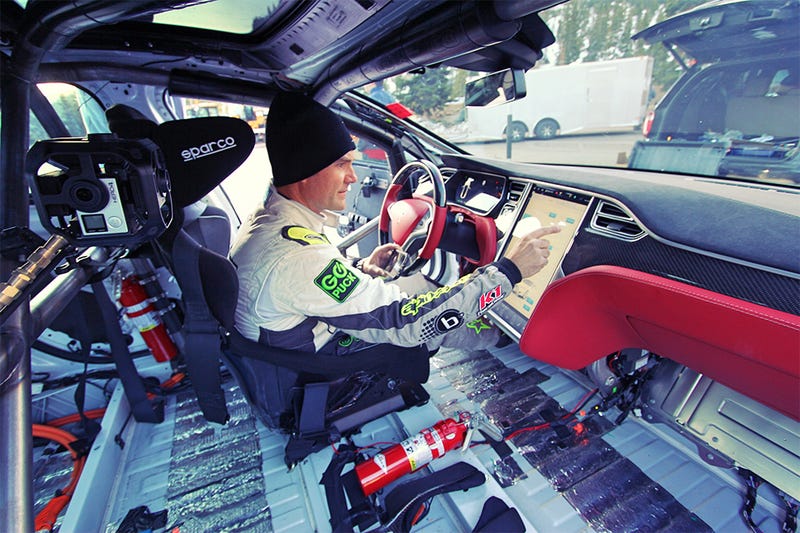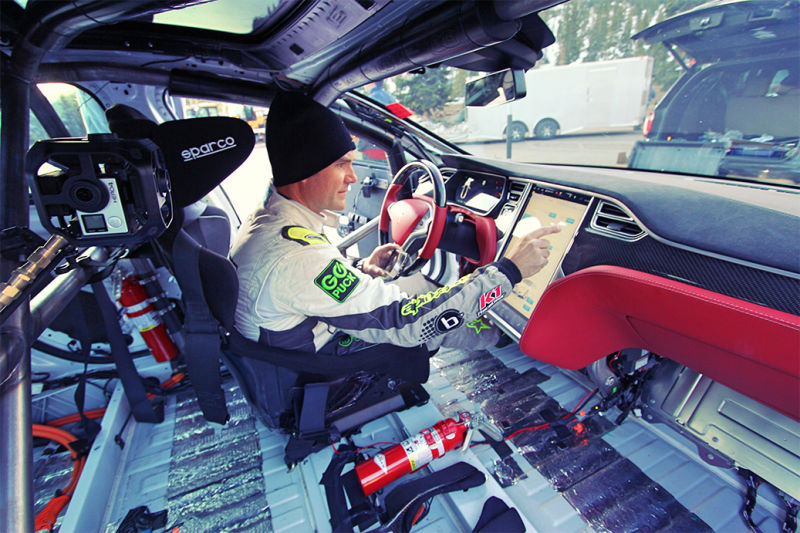
Blake Fuller’s Tesla Model S is being called “the fastest production electric vehicle” to ever race the Pikes Peak International Hill Climb after finishing the event with an impressive sub-12 minute time. I’m not sure if it’s really “production” at this point, but it’s undoubtedly quick.
Last weekend marked the 100th anniversary (and 94th running) of the Pikes Peak International Hill Climb—the only place to go car racing at almost three miles above sea level. It’s a 12.42 mile hard-charge uphill with 156 turns, nearly all of which are hairpins. Fuller’s time in his Tesla was 11:48.264, according to the official results.
Here’s a practice run clip to give you an idea of what running the car looked like:
Advertisement
Of course the real star of the show was Frenchman Romain Dumas, who casually laid down the second-fastest time in the event’s history in the latest version of the Norma M20 RD Limited. That’s a purpose-built 1,300-pound AWD missile of a car with a “one to one power to weight ratio” according to Motorsport. Dumas, who won the 24 Hours Of LeMans a few days prior, set the best time of the day at 8:51.445.
Sponsored
The fastest electric car was hot on his heels though; Rhys Millen’s eO which clocked in at 8:57.118.
The slowest recorded time went to rookie John Stallworth who drove a 2014 Polaris XP 1000, yes a Side-by-Side ATV, up the mountain in 21:23.417.
But since so many folks have developed a weird obsession with Tesla (sure, I’ll admit it) Fuller’s entry in the Electric Production class was one to watch.
According to the the rulebook, a vehicle racing this class is are supposed to represent “a production vehicle readily available to the public,” plus adjustments for safety like carpet and airbag removal, the installation of a roll cage and seats appropriate for racing.
Advertisement
Electrek says Fuller’s Model S lost about 800 pounds in its redress for racing, presumably gaining a few back with the safety mods.
But controversy is burbling around backchannels in regards to the true “production” status of the car.
“We don’t have a 100,000-mile capacity for this car,” Fuller told The Drive, meaning that the car’s battery had been modified for maximal power discharge rather than a long operational life. “The [stock] battery pack is five times larger than it needs to be to run up the mountain.”
Racing News, Autoevolution, and the other previously cited articles all describe the car’s battery as “modified.” In addition to tuning in efficiency, rumors are rolling around that Fuller’s race car’s battery is as much as 80 percent lighter than a factory Tesla’s.
Fuller, a storied racer with credentials in F1, IndyCar and NASCAR in addition to Pikes Peak, explained his interpretation of the Production Electric Vehicle class to Autoevolution:
One can tell how new the class for Production EV happens to be by how few modification allowances are within this class. As a “production class,” one must look at the spirit of the class: what can someone go buy today from a dealer, make safe and then go racing.
The production class for cars like Porsche, BMW, and Audi are always “open to interpretation” as these vehicles offer so many customer-specific ordering or performance packages, either factory direct or at local “performance-minded” dealers. For example, a Porsche could literally be ordered from the factory painted with a full racing livery, full race cage and a host of modifications giving 10, 20 or even 50 percent better performance in some aspects than a standard model.
At this point, Tesla’s dealer network is still being grown and the main goal is to serve the ever-increasing demand for these advanced technology vehicles. What Tesla has done is very impressive for a company only about 10 years old! We have taken the spirit of advancement of Tesla and chosen our modifications to be within the rules, from the Tesla parts bin and using the minds of some of the greatest problem solvers in the industry to first and foremost meet the safety rules of the class and also stay well within the spirit of the production class.
To sum it up, less weight, more efficiency and a focus on completing what is a very challenging task of building the very first Tesla Race Car. We are establishing a new era, a new baseline, and discovering a world of areas of innovation along the way!
Apparently that was enough to convince the Pikes Peak Hill Climb officials that Fuller’s car was close enough to “production” spec, and I’m sure you’ll share whether or not you agree in the comments.
Meanwhile, we’ve reached out to Fuller’s team to see if we can get some more specifics on how exactly the Tesla’s battery was made ready to race. Regardless of how it was done, the time’s impressive and totally sets the foundation for for a Spec Model S racing series.
Just kidding. That’d be cool though.













